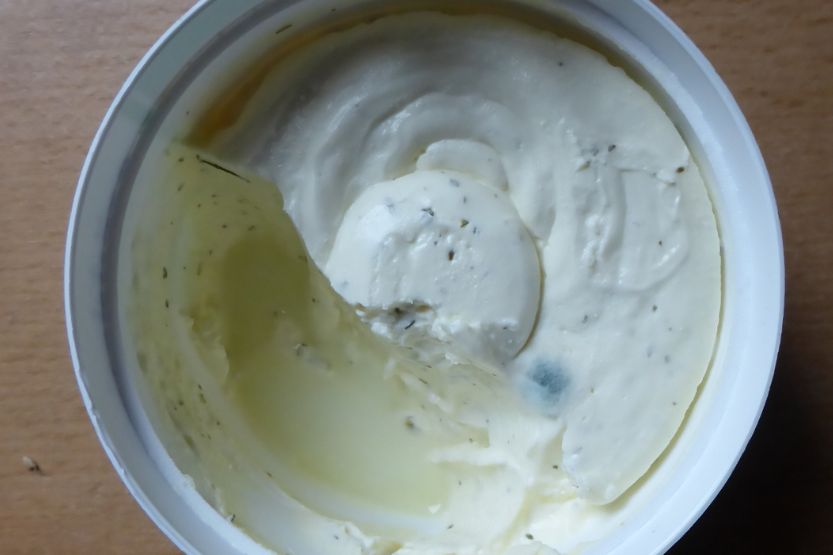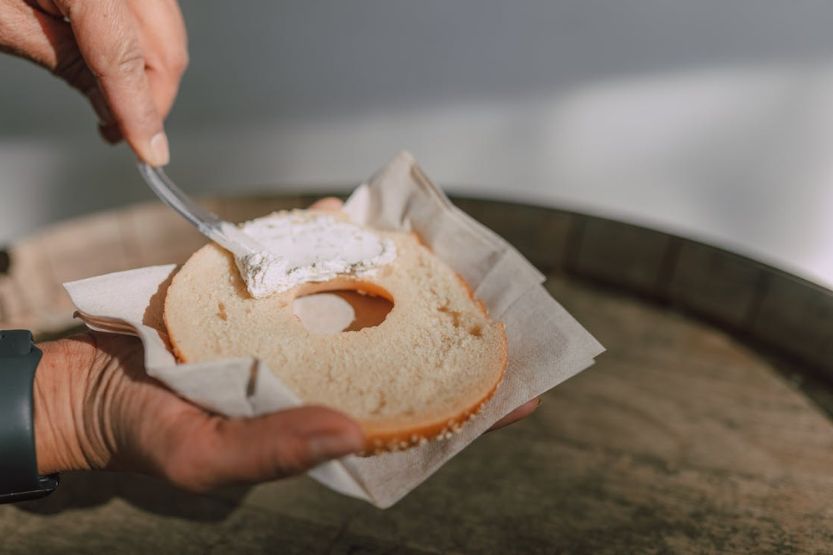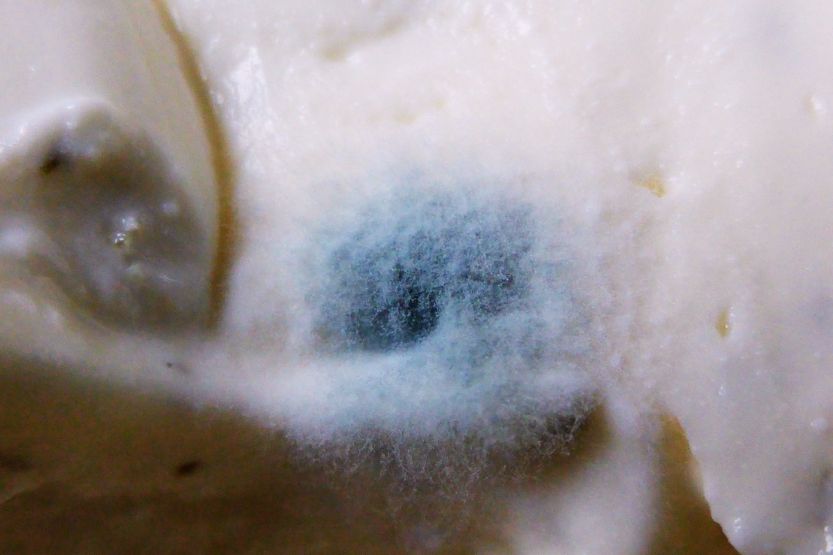If you’ve seen mold on cream cheese, you may not know whether to toss it or eat it. Mold is gross, sure, but some molds are safe to eat. So what if you see mold on cream cheese? Should you still eat it?
Mold on cream cheese is not safe to eat. So if you see mold on cream cheese, throw it out. Threads of mold can be sent throughout the cheese, contaminating more than you can see. Along with the mold, harmful bacteria like Salmonella, Listeria, Brucella, and E. coli can also grow on moldy cream cheese.
Read on to know if mold on cream cheese is safe to eat, what to do if you’ve already eaten some moldy parts, and some tips to prevent moldy cream cheese.
Mold on Cream Cheese

What Is Cream Cheese?
Cream cheese is a spreadable, soft cheese usually made from milk and cream. It can be flavored with herbs, spices, and other ingredients. The texture of cream cheese is smooth and melts well in cooking or baking. You can even use it as a butter substitute in recipes.
What Is Mold?
Molds are fungi that grow on the surface of the food. They are often found on blue cheeses (Gorgonzola, Roquefort) or sift-ripened cheeses (Brie, Camembert) because they contain mold spores, which were initially added during the production process.
Some people like to eat these cheeses because they think that they taste better when they have developed a rind of mold.
Cheeses Made with Mold
The cheeses that are made with mold include the following:
- Brie,
- Camembert,
- Roquefort, and
- Stilton.
Unique Texture Due to the Mold
These cheeses are made from cow’s milk, but they have a different texture and taste due to the mold used in the process. The mold is usually added after the cheese has been made and allowed to age for some time.
Unique Flavors and Aroma
The use of mold in cheesemaking is important because it imparts unique flavors and aromas to the finished product. These characteristics make these cheeses so famous and well-loved by many people.
High Overall Quality
The molds can improve the quality of cheeses, making them in demand to consumers.
Why Does Cream Cheese Get Pink?
Pinkish Color Around the Edges
Occasionally, cream cheese may take on a pinkish color, often visible around the edges of the rind. The cheesemaking industry considers this pink discoloration a defect, and if found in a cream cheese before shipment, it will be discarded entirely.
Does Not Pose a Danger to the Consumers
But it’s important to note that the only reason cream cheese is discarded following the discovery of this discoloration is its aesthetic defects. Pinking poses no danger to consumers.
Why Does Cream Cheese Turn Pink?
This pinking discoloration on cream cheese and other types of cheese has never been conclusively explained. However, many hypotheses exist, including:
Direct Chemical Reaction
A change in cheese constituents is caused by a direct chemical reaction, such as a change in annatto, a natural colorant to other colored chemicals due to sunlight, or the Maillard reaction of cheese components.
Microbial Action
Certain lactic or propionic acid bacteria, such as Lactobacillus helveticus used frequently in Swiss-style cheeses, may produce a microbial action on cheese components.
What Happens If You Eat Moldy Cream Cheese?
Most people will be able to handle eating moldy food without any problems so long as they don’t have an off taste or odor and don’t eat any visibly covered by mold.
However, consuming moldy cream cheese is potentially very dangerous. According to the U.S. Food and Drug Administration (FDA), moldy food can cause food poisoning and allergic reactions.
The CDC also states that many other potential health risks arise from eating moldy food, including stomachache and diarrheal illness.
Is Mold on Cream Cheese Harmful?
Food poisoning can be caused by various harmful bacteria, including E. coli, Listeria, Salmonella, and Brucella — all of which are found in molds.
These bacteria can trigger symptoms like vomiting, stomach pain, and diarrhea. In severe cases, it can be fatal.
Certain molds produce mycotoxins, which vary in toxicity but include immune deficiency and cancer as serious effects. The carcinogen aflatoxin is one example of a hazardous type of mold.
You can minimize your risk of exposure by avoiding eating moldy food like moldy cream cheese and practicing safe storage.
How Do You Keep Cream Cheese from Getting Moldy?

Mold on cream cheese is a common problem, but it doesn’t have to be. I’ve got a few tips for keeping your cream cheese mold-free and delicious:
1. Store Cream Cheese in the Fridge
Cream cheese is versatile but can’t survive at room temperature for very long. If you leave it out on the counter while you cook, be sure to use it up within a couple of hours.
If you put the cream cheese back in the fridge and notice mold forming, don’t panic! Remove the moldy part, place your cream cheese in a new container, and use your ingredients as planned.
2. Always Use a Clean Knife to Cut or Spread Cream Cheese
This will help to keep unwanted germs from contaminating your cream cheese. Do your best to avoid double-dipping, and be sure to clean your knife when you’re done using it regularly.
3. Do Not Leave Cream Cheese at Room Temperature for Too Long
Third, don’t leave the block at room temperature for too long. You might not realize it’s been sitting out there all day while busy doing other things.
4. Store Cream Cheese the Right Way
When stored properly, cream cheese will last up to two weeks. Keep it in its original packaging until you are ready to use it. If the package is damaged, discard it.
Use a plastic container if the cream cheese isn’t resealable (e.g., it’s in brick form). This will keep it from absorbing other odors in your fridge.
With these simple tips in mind, you’ll surely enjoy your cream cheese for weeks to come!
Again, mold on cream cheese: is it safe to eat? You should discard moldy cream cheese, soft cheese, ricotta, cottage cheese, and shredded, crumbled, or sliced cheese. Discarding is the way to go since the cheese has more molds than you can see.
What Is That White Stuff on Chocolate?
How to Properly Freeze Cream Cheese
Storing your cream cheese properly is key to ensuring it doesn’t spoil. Because of its high moisture content, cream cheese can easily spoil if not stored properly.
Luckily, keeping it in the refrigerator will keep it fresh for two weeks. But if you plan on storing it for longer than that, you have a few options:
1. Use an Airtight Container or Bag
To help increase the shelf life of cream cheese, you can freeze it. It’s important to remember that freezing cream cheese changes its texture, making it grainy. It might also become crumbly when thawed, making it more difficult to spread.
As a result, cream cheese should only be frozen if used in baked dishes, sauces, casseroles, or desserts rather than as a spread for bread, crackers, or bagels.
You can freeze cream cheese icings, frostings, dips, and spreads, but their textures will also become grainier.
2. Freeze Cream Cheese in Its Original Packaging
You can freeze unopened cream cheese in its original packaging, which will protect it against freezer burn and lengthen the shelf life.
3. Label the Cream Cheese Container
Label your container with the date before putting it in the freezer so you won’t lose track of how much time has passed.
Frozen cream cheese will last up to 2 months, but it’s best used within a month of freezing.
4. Make Sure It’s Tightly Wrapped
If you’re freezing cream cheese, make sure to do so in an airtight container or bag. This will help prevent freezer burn and keep the cream cheese fresh.
5. Leave Enough Room for Expansion
When freezing cream cheese, leave enough room for expansion. This will help prevent the cream cheese from cracking or breaking when it freezes.
Does String Cheese Need to Be Refrigerated? How Long Does It Last?
How to Properly Thaw Cream Cheese
When you’re ready to use your cream cheese, move it from the freezer into the fridge a day before you plan on using it.
Although it can take a long time for the cheese to defrost in the fridge, don’t thaw frozen cream cheese by leaving it out at room temperature. This could allow bacteria to grow.
When to Throw Out Moldy Cheese
If you see mold on cheese, you don’t necessarily have to discard it.
Hard cheeses like cheddar, colby, swiss, and parmesan usually don’t have spores spread too far beyond the surface. If you can see mold on one of these products, it’s safe to eat if they’ve been trimmed at least 1 inch or 2.5 cm around and below the spot where there was visible mold growth.
However, this technique can’t be applied to soft cheeses, including crumbled, shredded, and sliced cheese varieties.
Mold growth on these cheeses — including cream cheese, cottage cheese, and ricotta — suggests that the product is spoiled and should be discarded immediately.
Signs Your Cream Cheese Has Gone Bad

Here are some signs that your cream cheese has gone bad:
1. Moldy
If this happens, then throw it away immediately. Mold can be dangerous since it can contain toxins that make you sick if consumed.
2. Smells Sour or Rancid
You may notice a distinct sour or rancid smell if your cream cheese has gone bad. If so, throw it out and get some new cream cheese. But if your cream cheese smells sweet or smells like fresh milk, it’s probably fine to keep using.
3. Curdled
If your cream cheese is curdled, throw it away immediately because bacteria have gotten into the product and caused it to spoil faster than usual.
4. Slimy
If this happens, throw the product out because harmful bacteria are growing inside the container, making you sick if consumed by humans or animals alike (including pets).
5. Dry and Crumbly
Is your cream cheese dry and crumbly instead of a smooth and creamy texture? It’s probably gone bad. This can happen if you store your cream cheese for too long or its seal is broken.
If your cream cheese exhibits any of these signs, don’t risk it. Throw it away!
Frequently Asked Questions – Moldy Cream Cheese
Is It OK to Eat Moldy Cream Cheese?
Discard moldy soft cheeses, such as cottage cheese, cream cheese, and ricotta. The same goes for sliced, shredded, or crumbled cheese. The mold can send threads throughout it, contaminating more than you see.
What Happens If You Eat Moldy Cream Cheese Accidentally?
If you eat a small amount of cream cheese that has gotten moldy, you probably won’t get sick or feel any worse than if you hadn’t eaten it.
However, if you eat a large amount of moldy cream cheese (more than a few bites), there could be some side effects. These could include nausea, vomiting, diarrhea, abdominal cramps, and fever.
Call your doctor immediately if you have symptoms like these after eating something with moldy cream cheese.
Can You Eat Cream Cheese If You Remove the Moldy Part?
You can eat cream cheese if you remove the moldy part, but it’s best to toss the entire block.
If you remove only the moldy part, you risk a few things. You could ingest harmful bacteria that could cause food poisoning. You could spread the mold to other foods in your refrigerator or freezer. And you could miss out on essential nutrients because they are found in the moldy part of the cheese.
Can Cream Cheese Go Bad?
Yes, cream cheese can go bad. Different types of cream cheese have different shelf lives, but all types are susceptible to the same kinds of contamination and spoilage. It is important to keep a close eye on the expiration date and be wary of any mold or discoloration.
If you find yourself with an expired container of cream cheese, discard it in your trash bin outside (not in your sink or dishwasher).
Conclusion – Is Mold on Cream Cheese OK?
Not all types of mold are dangerous. Certain molds have beneficial uses, such as producing other cheese and antibiotics. However, mold is bad news in soft cheeses like cream cheese.
If you use cream cheese, it is essential to ensure it is not moldy. If you find any mold on your cream cheese, discard it immediately. Also, look for other signs of cream cheese spoilage, such as an off odor or taste, discoloration, and changes in texture.
The risk of mold on cream cheese is not a new one, but it’s worth taking seriously. Ensure to store your cream cheese in the fridge to prevent it from growing mold, and check the expiration dates to tell when it’s time to toss it out.




![Read more about the article How Long Does Almond Milk Last? [Opened and Unopened]](https://howchimp.com/wp-content/uploads/2020/09/how-to-tell-if-your-almond-milk-has-gone-bad-e1600419403753-300x200.jpg)

